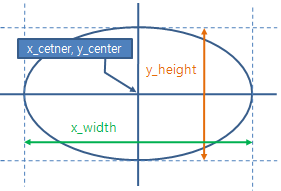
그래픽 & 멀티미디어
글 수 111
2007.04.25 22:28:33 (*.239.53.178)
40305
원을 알아보았으니까 이번에는 타원을 알아봐야 갰지요. 역시 정수 계산만으로 타원을 그리는 방법입니다만 이렇게 실수를 사용하지 않고 타원을 그린다는 자체가 참 신기하기만 합니다.
한가지 아래의 코드는 제가 아주 오래전에 어디서 구한 코드입니다. 그런데 아쉽게도 코드를 구해놓고 정작 출처를 잊어버렸네요. 제 기억으로는 아래의 코드는 브레슨햄의 알고리듬을 이용한 것은 아닙니다. 그러나 나눗셈이 있더라도 루프 밖에 있고, 작업이 많은 루프 안에서는 역시 정수 덧셈과 뺄셈만 있습니다.
 구현한 함수는 ellipse() 로,
구현한 함수는 ellipse() 로,
void ellipse( int x_center, int y_center, int x_width, int y_height)
x_center, y_center 는 타원의 중심을 가리킵니다. x_width 와 y_height 는 타원의 폭과 높이를 지정하면 됩니다.
*** 혹 이글을 보시고 출처를 알고 계시거나 브레슨햄의 타원 코드를 가지고 계신 분이 계신다면 http://forum.falinux.com의 게시판에 알려 주신다면 매우 감사하겠습니다.
#include <stdio.h>
#include <stdlib.h>
#include <string.h> // abs
#include <unistd.h> // open/close
#include <fcntl.h> // O_RDWR
#include <sys/ioctl.h> // ioctl
#include <sys/mman.h> // mmap PROT_
#include <linux/fb.h>
int screen_width;
int screen_height;
unsigned short *fb_mapped;
void dot( int x, int y)
{
unsigned short *ptr;
if ( 0 <= x && 0 <= y && x < screen_width && y < screen_height)
{
ptr = fb_mapped + screen_width * y + x;
*ptr = 0xffff;
}
}
void ellipse( int x_center, int y_center, int x_width, int y_height)
{
int x_coor, y_coor;
long width, height;
long xone_squ, xtwo_squ;
long yone_squ, ytwo_squ;
long delta, dx, dy;
x_coor = 0;
y_coor = y_height;
width = x_width;
height = y_height;
xone_squ = width * width;
xtwo_squ = xone_squ << 1;
yone_squ = height * height;
ytwo_squ = yone_squ << 1;
delta = yone_squ - xone_squ *height + (xone_squ >> 2);
dx = 0;
dy = xtwo_squ * height;
while( dx < dy )
{
dot( x_center+x_coor, y_center+y_coor);
dot( x_center-x_coor, y_center+y_coor);
dot( x_center+x_coor, y_center-y_coor);
dot( x_center-x_coor, y_center-y_coor);
if( delta > 0 )
{
y_coor--;
dy -= xtwo_squ;
delta -= dy;
}
x_coor++;
dx += ytwo_squ;
delta += yone_squ + dx;
}
delta += ( 3*(xone_squ - yone_squ)/2 - (dx+dy)/2 );
while( y_coor >= 0 )
{
dot( x_center+x_coor, y_center+y_coor);
dot( x_center-x_coor, y_center+y_coor);
dot( x_center+x_coor, y_center-y_coor);
dot( x_center-x_coor, y_center-y_coor);
if( delta < 0 )
{
x_coor++;
dx += ytwo_squ;
delta += dx;
}
y_coor--;
dy -= xtwo_squ;
delta += xone_squ - dy;
}
}
int main( int argc, char **argv)
{
int fb_fd;
struct fb_var_screeninfo fbvar;
struct fb_fix_screeninfo fbfix;
int bytes_per_line;
int mem_size;
int ndx;
fb_fd = open( "/dev/fb", O_RDWR);
ioctl( fb_fd, FBIOGET_VSCREENINFO, &fbvar);
ioctl( fb_fd, FBIOGET_FSCREENINFO, &fbfix);
screen_width = fbvar.xres; // 스크린의 픽셀 폭
screen_height = fbvar.yres; // 스크린의 픽셀 높이
bytes_per_line = fbfix.line_length; // 한개 라인 당 바이트 개수
mem_size = bytes_per_line * screen_height;
fb_mapped = ( unsigned short *)mmap( 0,
mem_size,
PROT_READ|PROT_WRITE,
MAP_SHARED,
fb_fd,
0);
for ( ndx = 20; ndx < 200; ndx+=20)
{
ellipse( 250, 250, ndx, 200);
ellipse( 250, 250, 200, ndx);
}
for ( ndx = 10; ndx < 100; ndx+=10)
{
ellipse( 500, 400, ndx, 100);
ellipse( 500, 400, 100, ndx);
}
munmap( fb_mapped, mem_size);
close( fb_fd);
return 0;
}
실행을 하면 아래와 같이 출력됩니다.

태그 : *그래픽 *타원 *ellipse


